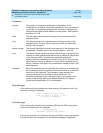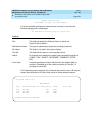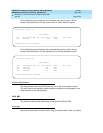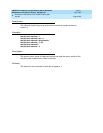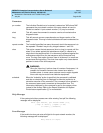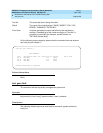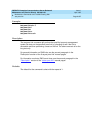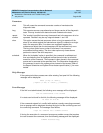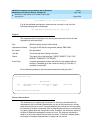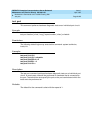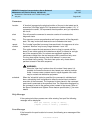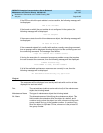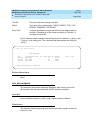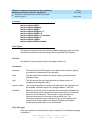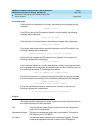
DEFINITY Enterprise Communications Server Release 5
Maintenance and Test for R5vs/si
555-230-123
Issue 1
April 1997
Maintenance Commands and Trouble-Clearing Aids
Page 8-638test pms-link
8
Parameters
Help Messages
If the system technician presses HELP after entering "test pms-link" the following
message will be displayed:
Enter [’long’ or ’short’],
[’repeat’ (1-100) or ’clear’], [’schedule’]
Error Messages
If the link is not administered, the following error message will be displayed:
Link not administered or not enabled
If no tests can be found for the link, the following message will be displayed:
No tests for this MO
If the command entered is in conflict with another currently executing command,
then a message will be displayed showing the login id of the conflicting user and
the conflicting command. The message is as follows:
’login id’:’command’ has a command conflict
If during the execution of a command a resource problem occurs that requires
the user to restart the command, then the following message will be displayed:
Command resources busy;
short This will cause the command to execute a series of nondestructive
diagnostic tests.
long This executes a more comprehensive and longer version of the diagnostic
tests. This may involve both destructive and nondestructive tests.
repeat
number
The "number" specifies how many times each test in the sequence is to be
repeated. "Number" may be any integer between 1 and 100.
clear This option causes the test sequence (short or long) to repeat until the
alarm (if one exists against the maintenance object) is cleared or a single
test in the sequence fails. If no alarms are registered against the
maintenance object then the test sequence will be exercised only once.
The long clear option forces a clear of all alarms if no errors are
encountered during testing. The short clear option only clears alarms
pertinent to tests in the short sequence.
schedule When the "schedule" option is specified, the command is validated and
then a scheduling form is displayed to allow the technician to schedule
execution of the command. The command is then placed in the command
queue and is executed at the specified time. The information displayed by
the command is sent to the system printer instead of the screen. Refer to
the Report Scheduler and System Printer feature specification [1] for more
details.



